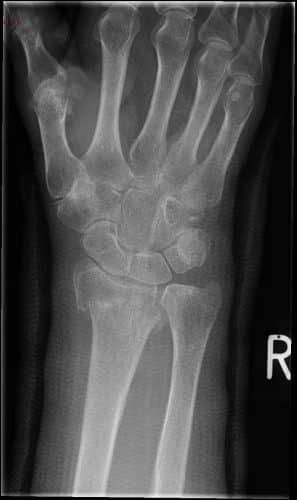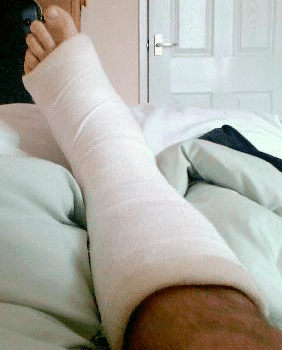Introduction
The most important adage to remember for the surgical management in traumatic orthopaedic complaints is ‘Reduce – Hold – Rehabilitate’
In the context of high-energy injuries, this is precluded by resuscitation following ATLS (Advanced Trauma Life Support) principles (beyond the scope of this article).
Reduce
Principles of Reduction
Reduction involves restoring the anatomical alignment of a fracture or dislocation of the deformed limb. Reduction allows for:
- Tamponade of bleeding at the fracture site
- Reduction in the traction on the surrounding soft tissues, in turn reducing swelling*
- Reduction in the traction on the traversing nerves, therefore reducing the risk of neuropraxia
- Reduction of pressures on traversing blood vessels, restoring any affected blood supply
The main principle in any reduction, regardless of the method employed, is to correct the deforming forces that resulted in the injury.
Fracture reduction is typically performed closed in the Emergency Room. However, some fractures need to be reduced open (by directly visualising the fracture and reducing it with instruments) intra-operatively.
*Excessively swollen soft tissues have higher rates of wound complications and surgery may be delayed to allow this to regress
Clinical Requirements
Reduction is painful and requires analgesia. Where regional or local blockade is both sufficient and easily provided (e.g. phalangeal/metacarpal/distal radius fractures), this would be the method of choice.
More commonly, the patient requires a short period of conscious sedation, often can provided in the Emergency Department where there is access to anaesthetic agents, airway adjuncts, and monitoring (such as in a specialist anaesthetic room or in a resuscitation area)
The specific manoeuvre used invariably requires two people (one to perform the reduction manoeuvre and one to provide counter-traction), with a third person needed to apply the plaster.

Figure 1 – AP radiograph of a distal radial fracture in plaster cast, post-initial attempted reduction
Hold
‘Hold’ is the generic term used to describe immobilising a fracture.
Initially, it is important to consider whether traction is needed, such as for subtrochanteric neck of femur fractures, femoral shaft fractures, displaced acetabular fractures, or certain pelvic fractures. Most commonly this is where the muscular pull across the fracture site is strong and the fracture is inherently unstable.
There most common ways to immobilise a fracture are via simple splints or plaster casts. When applying a plaster cast, the most important principles to remember are:
- For the first 2-weeks, plasters are not circumferential (not always the case in children)
- They must have an area which is only covered by the overlying dressing, to allow the fracture to swell; if this principle is not adhered to, the cast will become tight (and subsequently painful) overnight, and if left the patient is at risk of compartment syndrome
- If there is axial instability (whereby the fracture is able to rotate along its long axis), such as combined tibia-fibula metaphyseal fractures or combined radius-ulna metaphyseal fractures, the plaster should cross both the joint above and below
- These are usually termed ‘above knee’ or ‘above elbow’ plasters, respectively, preventing the limb to rotate on its long axis; for most other fractures, the plaster need only cross the joint immediately distal to it
Clinical Requirements
There are several important clinical points regarding fracture immobilisation:
- Can the patient weight bear?
- This varies depending on fracture, however you should always inform the patient of this
- Do they need thromboprophylaxis?
- If the patient is immobilised in a cast and is non-weight bearing, it is common to provide thromboprophylaxis
- Have you provided advice about the symptoms of compartment syndrome?
- Patients should be advised that if they develop any features of compartment syndrome to return to A&E for further assessment
Remember, the definitive method of ‘holding’ the fracture might be surgical intervention.
Rehabilitate
This refers to the need for most patients to undergo an intensive period of physiotherapy following fracture management.
Invariably, patients are stiff following immobilisation and therapists are therefore essential to successful recovery. It is therefore also important to ensure that patients are advised to move non-immobilised unaffected joints from the outset.
It is also important to remember that many fractures occur in frailty and render the patient with an inability to weight bear or use an arm, having profound effects on their ability to cope at home. Therapists are therefore essential in making sure that this group have suitable adaptations implemented for them during their recovery.
Key Points
- The surgical management in traumatic orthopaedic complaints can be summarised into “Reduce – Hold – Rehabilitate”
- Reduction will often be performed by orthopaedic specialist, with the aim to restore the anatomical alignment of a fracture or dislocation
- Fractures will need immobilisation +/- traction to ensure successful healing
- Rehabilitation will ensure a successful clinical outcome following initial management, especially important in elderly populations

